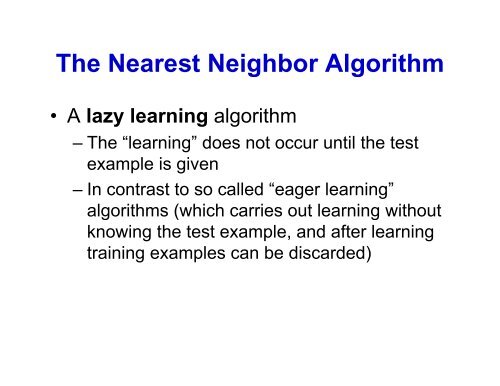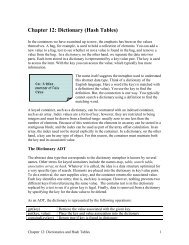The Nearest Neighbor Algorithm - Classes
The Nearest Neighbor Algorithm - Classes
The Nearest Neighbor Algorithm - Classes
Create successful ePaper yourself
Turn your PDF publications into a flip-book with our unique Google optimized e-Paper software.
<strong>The</strong> <strong>Nearest</strong> <strong>Neighbor</strong> <strong>Algorithm</strong><br />
• A lazy learning algorithm<br />
– <strong>The</strong> “learning” does not occur until the test<br />
example is given<br />
– In contrast to so called “eager learning”<br />
algorithms (which carries out learning without<br />
knowing the test example, and after learning<br />
training examples can be discarded)
<strong>Nearest</strong> <strong>Neighbor</strong> <strong>Algorithm</strong><br />
• Remember all training examples<br />
• Given a new example x, find the its closest training<br />
example and predict y i New example<br />
• How to measure distance – Euclidean (squared):<br />
x − x<br />
i<br />
2<br />
= ∑(<br />
x − x<br />
j<br />
j<br />
i<br />
j<br />
)<br />
2
Decision Boundaries: <strong>The</strong> Voronoi Diagram<br />
• Given a set of points,<br />
a Voronoi diagram<br />
describes the areas<br />
that are nearest to<br />
any given point.<br />
• <strong>The</strong>se areas can be<br />
viewed as zones of<br />
control.
Decision Boundaries: <strong>The</strong> Voronoi Diagram<br />
• Decision boundaries are formed<br />
by a subset of the Voronoi<br />
diagram of the training data<br />
• Each line segment is<br />
equidistant between two points<br />
of opposite class.<br />
• <strong>The</strong> more examples that are<br />
p<br />
stored, the more fragmented<br />
and complex the decision<br />
boundaries can become.
Decision Boundaries<br />
With large number of examples<br />
and possible noise in the labels,<br />
the decision i boundary can<br />
become nasty!<br />
We end up overfitting the data
Example:<br />
K-<strong>Nearest</strong> <strong>Neighbor</strong><br />
K = 4<br />
New example<br />
Find the k nearest neighbors and have them vote. Has a<br />
g<br />
smoothing effect. This is especially good when there is noise<br />
in the class labels.
Effect of K<br />
K=1 K=15<br />
Figures from Hastie, Tibshirani and Friedman (Elements of Statistical Learning)<br />
Larger k produces smoother boundary effect and can reduce the<br />
impact of class label noise.<br />
But when K = N, we always predict the majority class
Question: how to choose k?<br />
• Can we choose k to minimize the mistakes that we make<br />
on training examples (training error)?<br />
K=20 K=1<br />
A model selection<br />
problem that we will<br />
Model complexity<br />
study later
Distance Weighted <strong>Nearest</strong> <strong>Neighbor</strong><br />
• It makes sense to weight the contribution of<br />
each example according to the distance to the<br />
new query example<br />
– Weight varies inversely with the distance, such that<br />
examples closer to the query points get higher weight<br />
• Instead of only k examples, we could allow all<br />
training examples to contribute<br />
– Shepard’s method (Shepard 1968)
Curse of Dimensionality<br />
• kNN breaks down in high-dimensional space<br />
– “<strong>Neighbor</strong>hood” becomes very large.<br />
• Assume 5000 points uniformly distributed in the unit hypercube and<br />
we want to apply 5-nn. Suppose our query point is at the origin.<br />
– In 1-dimension, we must go a distance of 5/5000 = 0.001 on the<br />
average to capture 5 nearest neighbors<br />
– In 2 dimensions, we must go 0.001 to get a square that contains<br />
0.001 of the volume.<br />
– In d dimensions, we must go (0.001) 1/d
<strong>The</strong> Curse of Dimensionality:<br />
Illustration<br />
• With 5000 points in 10 dimensions, we must go 0.501<br />
distance along each dimension in order to find the 5<br />
nearest neighbors
<strong>The</strong> Curse of Noisy/Irrelevant Features<br />
• NN also breaks down when data contains irrelevant/noisy features.<br />
• Consider a 1-d problem where query x is at the origin, our nearest<br />
neighbor is x 1 at 0.1, and our second nearest neighbor is x 2 at 0.5.<br />
• Now add a uniformly random noisy feature.<br />
– P(||x 2 ’ - x||
Curse of Noise (2)<br />
Location of x 1 versus x 2<br />
’ - x||
Problems of k-NN<br />
• <strong>Nearest</strong> neighbor is easily misled by noisy/irrelevant<br />
features<br />
• One approach: Learn a distance metric:<br />
– that weights each feature by its ability to minimize the prediction<br />
error, e.g., its mutual information i with the class.<br />
– that weights each feature differently or only use a subset of<br />
features and use cross validation to select the weights or feature<br />
subsets<br />
– Learning distance function is an active research area
<strong>Nearest</strong> <strong>Neighbor</strong> Summary<br />
• Advantages<br />
– Learning is extremely simple and intuitive,<br />
iti – Very flexible decision boundaries<br />
– Variable-sized hypothesis space<br />
• Disadvantages<br />
– distance function must be carefully chosen or tuned<br />
– irrelevant or correlated features have high impact and must be<br />
eliminated<br />
– typically cannot handle high dimensionality<br />
– computational costs: memory and classification-time time<br />
computation<br />
• To reduce the cost of finding nearest neighbors, use data structure<br />
such as kd-tree

















